2.3 Connecting to a Wireless Network
Up to this point, I have discussed the various standards in wireless networks, in particular the IEEE 802.11 specifications. All the theoretical discussions are not very exciting unless you get your hands dirty and try to set up a wireless network yourself. In the following sections, I show you how to connect to a wireless network using three different wireless cards and adapters.
Although I demonstrate each example using different hardware from Cisco, D-Link, and Linksys, wireless hardware vendors use the same or similar chipsets in their equipment. So, the installation and configuration procedures will be somewhat similar across different vendors and different product lines from the same vendor. You should still consult the documentation that comes with your hardware before installing anything.
Most wireless cards in the market today use the following chipsets:
Atmel
Broadcom
Lucent Hermes
Intersil PRISM-II and Intersil PRISM-2.5
Symbol Spectrum24
TI wireless
Some newer 802.11g wireless products (such as those from Linksys) use the Broadcom chipset.
CentrinoIntel's Centrino technology initiative promises smaller laptops with extended battery life and mobile features such as 802.11b networking. For the most part, this means that you're buying a laptop with the Wi-Fi technology embedded deep inside the computer. At the time of this writing, Centrino is 802.11b only, and there is no indication that a Centrino laptop would be upgradeable to 802.11g or 802.11a. So, if you purchase a Centrino laptop, you need to obtain an 802.11a adapter to connect to an 802.11a-only network; you could connect to an 802.11g network, but only at 802.11b speeds. Despite this limitation, a Centrino laptop may be right for you if you're only planning to use 802.11b. For insight on what the bigger picture entails, see Glenn Fleishman's "Centrino: Trojan Horse for Future Cell Data" at http://wifinetnews.com/archives/001589.html. |
Table 2-4 shows a list of common wireless cards available in the market (all are PC cards unless stated otherwise).
|
Card |
Chipset |
|---|---|
|
3Com AirConnect 3CRWE737A |
Spectrum24 |
|
3Com AirConnect 3CRWE777A (PCI) |
PRISM-II |
|
Actiontec HWC01170 |
PRISM-2.5 |
|
Actiontec HWC01150 |
Atmel |
|
Addtron AWP-100 |
PRISM-II |
|
Agere Orinoco (Lucent) |
Hermes |
|
Apple Airport |
Hermes |
|
Buffalo AirStation |
PRISM-II |
|
Buffalo AirStation (CF) |
PRISM-II |
|
Cabletron RoamAbout |
Hermes |
|
Compaq Agency NC5004 |
PRISM-II |
|
Contec FLEXLAN/FX-DS110-PCC |
PRISM-II |
|
Corega PCC-11 |
PRISM-II |
|
Corega PCCA-11 |
PRISM-II |
|
Corega PCCB-11 |
PRISM-II |
|
Corega CGWLPCIA11 (PCI) |
PRISM-II |
|
D-Link DWL-520 (PCI) |
PRISM-2.5 |
|
D-Link DWL-650 |
PRISM-2.5 |
|
D-Link DWL-650+ |
TI Chipset |
|
D-Link DWL-660 |
TI Chipset |
|
ELSA XI300 |
PRISM-II |
|
ELSA XI325 |
PRISM-2.5 |
|
ELSA XI325H |
PRISM-2.5 |
|
ELSA XI800 (CF) |
PRISM-II |
|
EMTAC A2424i |
PRISM-II |
|
Ericsson Wireless LAN CARD C11 |
Spectrum24 |
|
Gemtek WL-311 |
PRISM-2.5 |
|
Hawking Technology WE110P |
PRISM-2.5 |
|
I-O DATA WN-B11/PCM |
PRISM-II |
|
Intel PRO/Wireless 2011 |
Spectrum24 |
|
Intersil PRISM-II |
PRISM-II |
|
Intersil Mini (PCI) |
PRISM-2.5 |
|
Linksys Instant Wireless WPC11 |
PRISM-II |
|
Linksys Instant Wireless WPC11 2.5 |
PRISM-2.5 |
|
Linksys Instant Wireless WPC11 3.0 |
PRISM-2.5 |
|
Lucent WaveLAN |
Hermes |
|
Nanospeed ROOT-RZ2000 |
PRISM-II |
|
NDC/Sohoware NCP130 (PCI) |
PRISM-II |
|
NEC CMZ-RT-WP |
PRISM-II |
|
Netgear MA401 |
PRISM-II |
|
Netgear MA401RA |
PRISM-2.5 |
|
Nokia C020 Wireless LAN |
PRISM-I |
|
Nokia C110/C111 Wireless LAN |
PRISM-II |
|
NTT-ME 11Mbps Wireless LAN |
PRISM-II |
|
Proxim Harmony |
PRISM-II |
|
Proxim RangeLAN-DS |
PRISM-II |
|
Samsung MagicLAN SWL-2000N |
PRISM-II |
|
Symbol Spectrum24 |
Spectrum24 |
|
SMC 2632 EZ Connect |
PRISM-II |
|
TDK LAK-CD011WL |
PRISM-II |
|
US Robotics 2410 |
PRISM-II |
|
US Robotics 2445 |
PRISM-II |
I'll start by showing you how to connect to a wireless network. I will illustrate using two wireless cards ? the Cisco Aironet 350 and the D-Link DWL-650+, and one USB wireless adapter. I'll take a look at the Cisco Aironet 350 first.
2.3.1 Using a Plug-and-Play PCMCIA Wi-Fi Card
The Cisco Aironet 350 wireless card (see Figure 2-5) is an 802.11b card. This is my preferred card as it is truly plug-and-play ? plug this into your PCMCIA slot and Windows XP will connect to the network in seconds! Windows XP includes a driver for this card so there is no need for you to manually install the drivers.
Figure 2-5. The Cisco Aironet 350 wireless card

For this section, you need the following:
A Windows XP notebook computer with a vacant PCMCIA slot
An existing wireless network (see Chapter 5 for information on setting up a wireless network)
The Cisco Aironet 350 wireless card
Take the following steps:
Insert the Cisco Aironet 350 into your computer's PCMCIA slot.
Windows XP will automatically detect the card and install the necessary drivers for it.
Windows XP will then automatically discover any available wireless networks. The Wireless Network Connection icon can be found in the system tray. This is shown in Figure 2-6.
Click on the Wireless Network Connection icon in the tray to view all the available wireless networks. Figure 2-7 shows the two available networks with the SSIDs: MyOffice and default.
MyOffice has WEP enabled. When you select it, you have to enter a network key. default does not have WEP enabled, so when you select it, you have to turn on the "Allow me to connect to the selected wireless network, even though it is not secure" option (see Figure 2-8).
You can click on the Advanced button to add your own preferred wireless network (see Figure 2-9). This is useful when you use your computer in different places such as home and the office. In the Wireless Networks tab (see Figure 2-9), there are two sections: Available networks and Preferred networks. Available networks list the SSIDs of the all wireless networks in range. Preferred networks show all the SSIDs of wireless networks in range plus the networks that you used in the past. If your wireless network does not broadcast its SSID, you need to add it manually using the Add button.
Figure 2-6. The Wireless Network Connection icon in the Tray

Figure 2-7. Specifying a WEP key for a WEP-secure wireless network
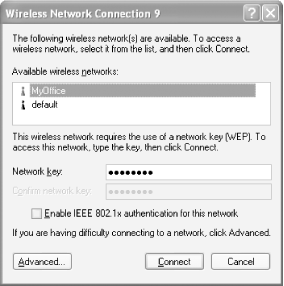
Figure 2-8. Connecting to an unsecured wireless network
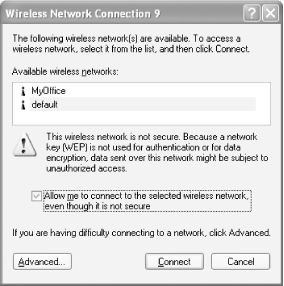
Windows XP Wireless Zero ConfigurationWindows XP provides a Wireless Zero Configuration service.
This service is automatically run when your computer is started. You
can locate this service in Start When the Wireless Zero Configuration service is started, Windows XP will detect the wireless network(s) present and connect to one automatically. However, if a wireless network has disabled SSID broadcast, Windows XP will not be able to detect the network. In such cases, you need to manually add your wireless network connection (SSID) to the Preferred networks section (click the Advanced button shown in Figure 2-7 and Figure 2-8); Windows XP will automatically connect to the network when it is available again. |
Figure 2-9. Manually adding a wireless network
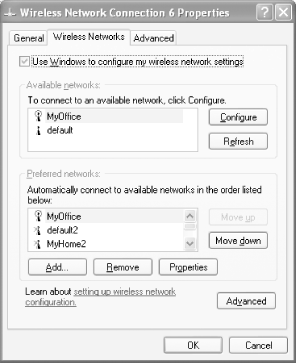
|
Figure 2-10. Windows can automatically display all the available wireless networks
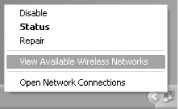
SSID Broadcast and MAC Address FilteringYou will not be able to see the SSID of the network available if the wireless access point has disabled SSID broadcast. To join the network, you need to manually add in the SSID of the network under the Preferred networks section as shown in Figure 2-9. If the access point uses MAC filtering (and enables SSID broadcast), you would be able to see the SSID of the network but would not be able to connect to it unless your MAC address is in the allow-access list. For information on configuring MAC address filtering, see Chapter 5. |
2.3.1.1 Using the Cisco Aironet Client Utility (ACU)
The Cisco Aironet 350 comes with the Aironet Client Utility (ACU), as shown in Figure 2-11. Strictly speaking, you do not need this for the 350 to work, since Windows XP supports the card natively. You can also download the ACU from http://www.cisco.com/pcgi-bin/tablebuild.pl/aironet_utilities_windows.
Figure 2-11. The Cisco Aironet Client Utility

The ACU comes with an interesting Link Status function that displays the signal strength graphically (see Figure 2-12). This is useful when you need to know where to position yourself so that you get the maximum signal strength for best throughput (see Section 3.2.1).
Figure 2-12. The ACU displays the signal strength graphically
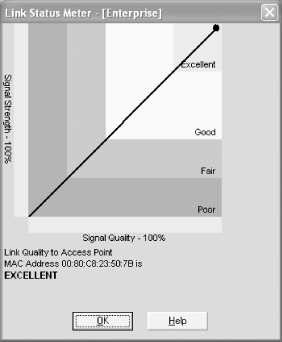
2.3.2 Using a PCMCIA Wi-Fi Card
The D-Link AirPlus DWL-650+ (see Figure 2-13) is an 802.11b wireless card. When used with another AirPlus product (such as the D-Link AirPlus DI-714P+ wireless router), the maximum raw transfer rate of 22 Mbps can be achieved. For this section, you need the following:
Figure 2-13. The D-Link DWL-650+ 802.11b wireless card

A Windows XP notebook computer with a vacant PCMCIA slot
An existing wireless network
The D-Link AirPlus DWL-650+ wireless card
2.3.2.1 Using the AirPlus utility
You should download and install the latest driver and utility from D-Link's web site at http://www.dlink.com/.
Known Conflicts Between Windows XP and the D-Link DWL-650+In my testing, the DWL-650+ sometimes conflicts with Windows XP. The AirPlus utility may connect you to a particular network, but after a while, Windows XP will automatically connect to another network, or the network may simply be disconnected. To solve this problem, disable the wireless zero configuration feature in Windows XP:
Once the Windows wireless zero configuration feature is turned off, the DWL-650+ should work perfectly. In general, if you encounter difficulties connecting to a wireless network, turn off Windows wireless zero configuration and use the utility provided by the wireless card vendor. Note that when you disable the Windows XP Wireless Zero Configuration service, you lose many of the advanced wireless features found in Windows XP. These include:
If you disable this service, you will need to use the configuration utility supplied by your wireless card vendor to connect to a wireless network. |
To install the DWL-650+, take the following steps:
Insert the DWL-650+ into the PCMCIA slot on your computer.
Windows XP will detect the presence of the card and search for a suitable driver.
If prompted for a driver, direct Windows XP to the drivers that you downloaded.
After the installation, the AirPlus utility icon should appear in the Tray, as shown in Figure 2-14 (the icon in the middle).
Figure 2-14. The AirPlus utility icon in the Tray
Double-click on the icon and the D-Link AirPlus utility window (see Figure 2-15) will appear.
Figure 2-15. Using the D-Link AirPlus utility
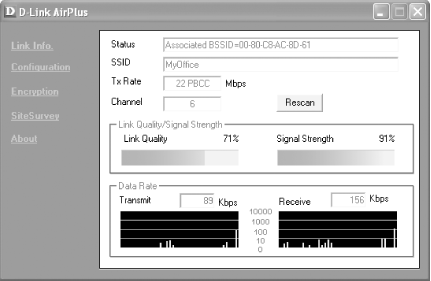
The AirPlus utility contains five main pages:
- Link Info
-
Displays information about the current connection. Displays the link quality, signal strength, and data rate graphically.
- Configuration
-
Allows configuration of the current wireless connection.
- Encryption
-
Specifies whether encryption is used for the wireless network. Also allows you to enter the key(s) used.
- SiteSurvey
-
Displays the available wireless network as well as allows you to manually add networks (see Figure 2-16).
- About
-
Displays copyright information and the firmware and utility version numbers.
Figure 2-16. Performing a site survey using the D-Link AirPlus utility
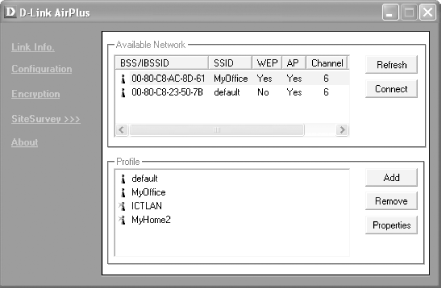
|
AirPlus TechnologyThe D-Link AirPlus product family uses the Texas Instruments' patented Digital Signal Processing technology for enhanced performance. When two products from the AirPlus family are used, it results in improved performance. However, the AirPlus family is also fully compatible with the 802.11b specification and thus will work with all other 802.11b products. |
Figure 2-16 shows the result of a site survey. Two wireless networks are detected. When a wireless network with WEP enabled is selected, you are prompted to enter a key, as shown in Figure 2-17.
Figure 2-17. Entering a WEP key
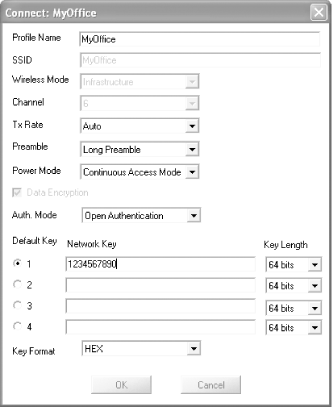
2.3.3 Using a USB Wi-Fi Adapter
The USB wireless adapter that I use in this section is the Linksys WUSB11 wireless adapter (see Figure 2-2, earlier in this chapter). The benefit of using a USB wireless adapter is that you can use it on your desktop PC as well as on a notebook. It is a useful alternative when you need to share an adapter among multiple computers.
To use the WUSB11, simply connect it to your USB port on your computer and Windows XP will prompt you for the drivers. You should use the drivers provided by Linksys or download them from Linksys's web site at http://www.linksys.com/.
2.3.3.1 Using the Linksys wireless configuration utility
Linksys provides the WUSB11 with a configuration utility. (See Figure 2-18: the utility is represented by a little green icon on the lower right corner. When the network is not present, the icon turns red.)
Figure 2-18. The Linksys configuration utility
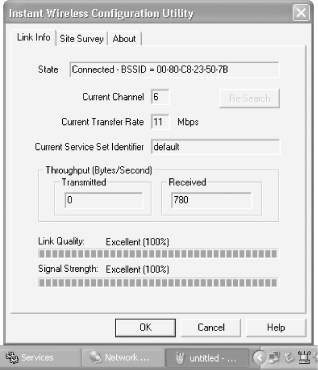
Using this configuration utility, you can perform a site survey and view the current link quality and signal strength.
 Settings
Settings 






